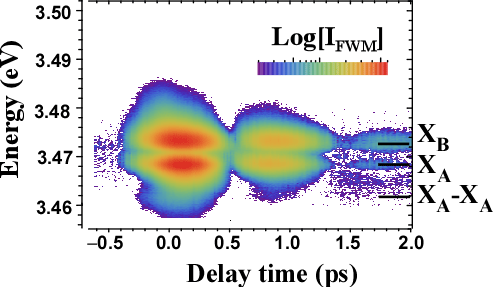TODA Group
Our group is a part of laboratory for Photo-electronic Materials.
Thank you for visiting. Please select the language ..... (English* or Japanese)
Research
BACK
Coherent spectroscopy
 In the conventional pump-probe spectroscopy (transient reflectivity and transmissivity), the signal reflects the photoinduced changes of transient electron density distribution. In this case, the two incident beams need not be coherent.
In the four-wave-mixing (FWM) spectroscopy, the two beams are necessary to be coherent so as to produce the interference of the coherent polarizations via optical nonlinearity. In the simplest form of FWM, polarization gratings are created by two beams of equal frequency, which is the so-called degenerate four-wave mixing (DFWM).
If the electron polarization induced by the first pump pulse keeps its coherence until the second probe pulse arrives, the probe pulse produces a coherent phase polarization grating, which diffracts the probe itself.
The time-evolution of such a self-diffraction signal gives information on phase coherence times.
A typical time-evolution of the DFWM spectrum is shown in the figure, where the two exciton transitions observed in a semiconductor GaN are visible. The simultaneous excitation of the two transitions shows a quantum beat oscillation in time domain. Moreover the resonance of the exciton molecule (XA-XA biexciton) can be identified.
In the conventional pump-probe spectroscopy (transient reflectivity and transmissivity), the signal reflects the photoinduced changes of transient electron density distribution. In this case, the two incident beams need not be coherent.
In the four-wave-mixing (FWM) spectroscopy, the two beams are necessary to be coherent so as to produce the interference of the coherent polarizations via optical nonlinearity. In the simplest form of FWM, polarization gratings are created by two beams of equal frequency, which is the so-called degenerate four-wave mixing (DFWM).
If the electron polarization induced by the first pump pulse keeps its coherence until the second probe pulse arrives, the probe pulse produces a coherent phase polarization grating, which diffracts the probe itself.
The time-evolution of such a self-diffraction signal gives information on phase coherence times.
A typical time-evolution of the DFWM spectrum is shown in the figure, where the two exciton transitions observed in a semiconductor GaN are visible. The simultaneous excitation of the two transitions shows a quantum beat oscillation in time domain. Moreover the resonance of the exciton molecule (XA-XA biexciton) can be identified.